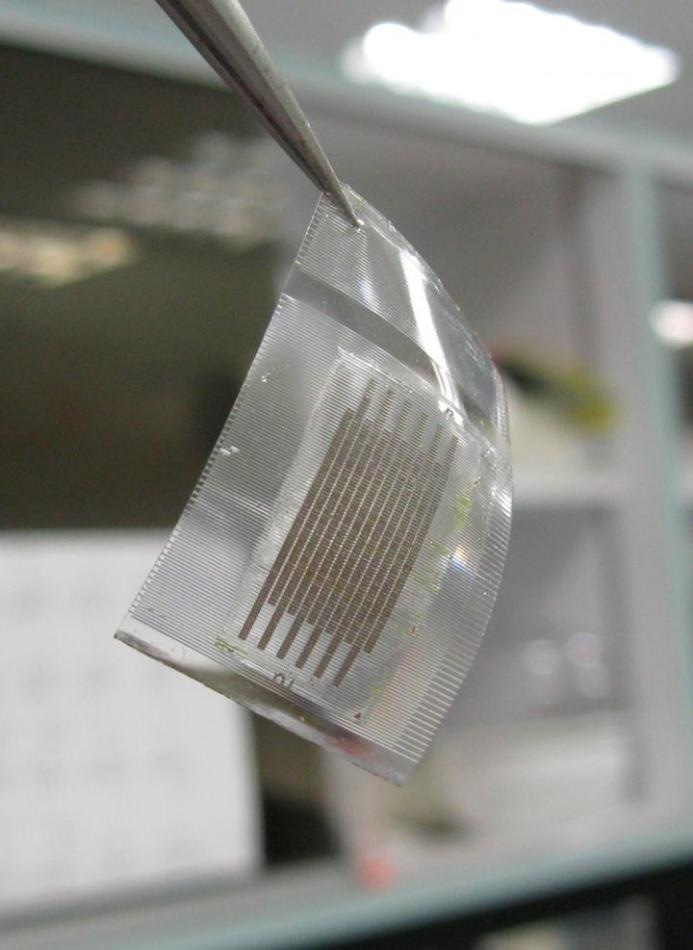Aug 25 2016
 This stretchy supercapacitor made from graphene could spur the development of wearable electronics. (Credit: Xiaodong Chen, Ph.D.)
This stretchy supercapacitor made from graphene could spur the development of wearable electronics. (Credit: Xiaodong Chen, Ph.D.)
The development of stretchy power sources would be a key factor in the development of soft robots capable of washing dishes or smart T-shirts capable of powering cell phones. Traditional batteries are rigid and thick, and therefore cannot be used in tiny malleable devices.
Recently, researchers have created a stretchy micro-supercapacitor with graphene ribbons, which is a step closer to creating wearable electronics.
The work was presented at the 252nd National Meeting & Exposition of the American Chemical Society (ACS), which is the largest scientific society in the world. The event features over 9,000 presentations on a broad range of science topics.
Most power sources, such as phone batteries, are not stretchable. They are very rigid. My team has made stretchable electrodes, and we have integrated them into a supercapacitor, which is an energy storage device that powers electronic gadgets.
Xiaodong Chen, Ph.D., Nanyang Technological University
Supercapacitors that were developed in the 1950s possess a higher power density and longer life cycle than typical batteries or capacitors.
As the size of devices has shrunk, supercapacitors have also had to shrink, which started the development of a generation of 2D micro-supercapacitors capable of being incorporated into computers, cell phones, and other devices. However, these supercapacitors are not flexible, and are not ideal for soft materials that need to possess the capability to elongate.
In the recent research, Chen of Nanyang Technological University, Singapore, and his team aimed to use graphene to create a micro-supercapacitor. Graphene is a carbon sheet that is recognized for its strength, thinness, and conductivity.
Graphene can be flexible and foldable, but it cannot be stretched. We started to think of how we could make graphene more like a wave.
Xiaodong Chen, Ph.D., Nanyang Technological University
The team, at first, created graphene micro-ribbons. A majority of graphene is made using physical techniques such as shaving the tip of a pencil. Chen chose to use chemistry to construct his material. “We have more control over the graphene’s structure and thickness that way,” he explains. “It’s very difficult to control that with the physical approach. Thickness can really affect the conductivity of the electrodes and how much energy the supercapacitor overall can hold.”
Subsequently, they produced the stretchable polymer chip using a sequence of pyramidal ridges. The graphene ribbons were placed by the researchers across the ridges to create the wave-like structure.
The design enabled the materials to be stretched without the graphene electrodes of the superconductor cracking, detaching, or deforming. Additionally, the team built kirigami structures, which are modifications of origami folds, to make the supercapacitors 500% more flexible without deforming their electrochemical performance.
Finally as a test, Chen powered an LCD from a calculator using the new stretchy graphene-based micro-supercapacitor. These stretchy supercapacitors can also be used in chemical or pressure sensors.
Going forward, the team plan to conduct more experiments so that the surface area of the electrode can be increased to contain even more energy.
The latest version, however, is capable of only storing enough energy to power LCD devices for a minute, he states.
Chen received financial assistance from the National Research Foundation, Prime Minister’s Office, Singapore, under its Campus for Research Excellence and Technological Enterprise (CREATE) Programme of Nanomaterials for Energy and Water Management.